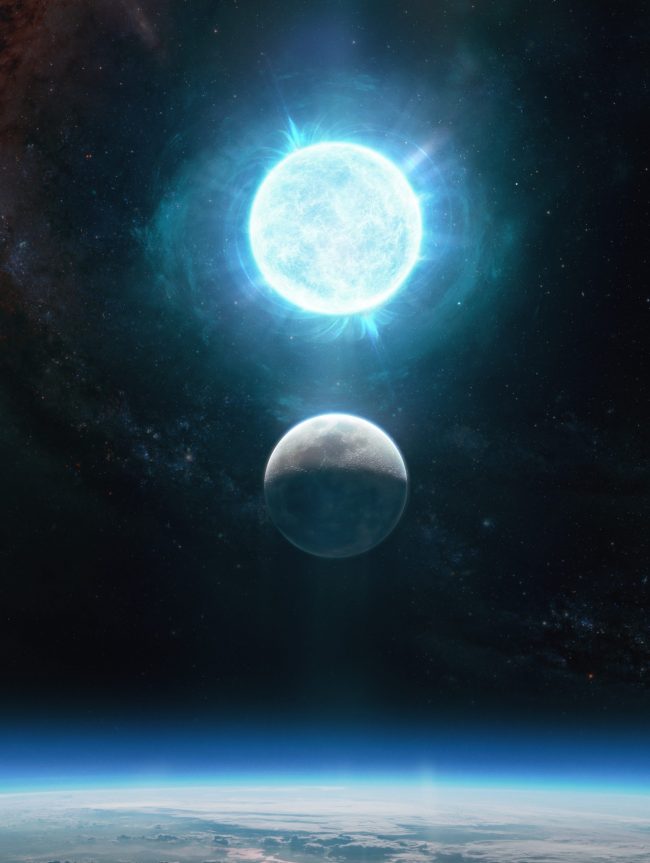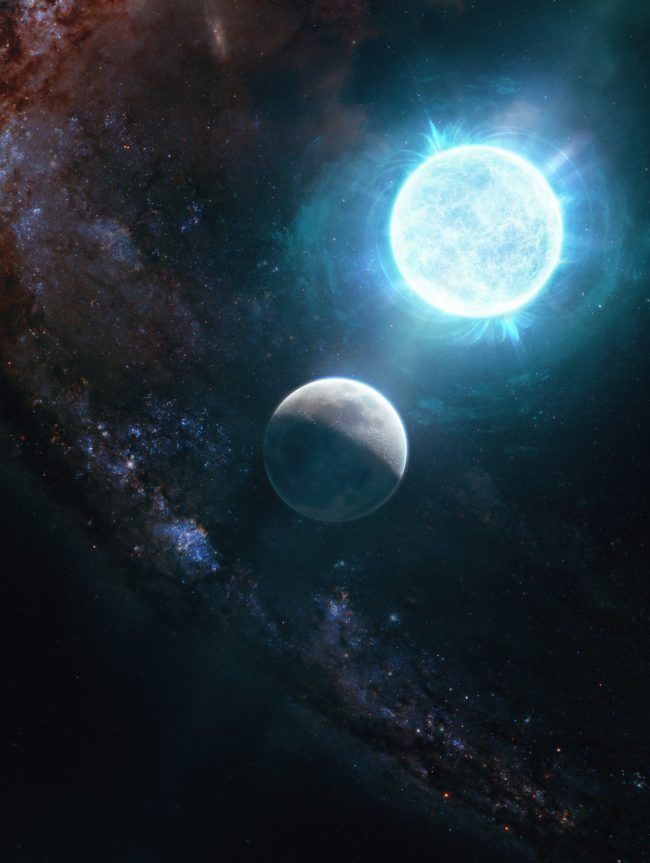
In late June, 2021, astronomers announced the discovery of the smallest and most massive white dwarf yet seen. It’s a star that’s so small and so massive, they said, it might be on the verge of collapse. A white dwarf is an evolved star. Our sun will someday become one. This particular white dwarf is named ZTF J1901+1458. It lies about 130 light-years away in the direction to the constellation Aquila the Eagle. This very massive white dwarf is thought to have formed when two less massive white dwarfs merged. Astrophysicist Ilaria Caiazzo at Caltech is lead author of the new study. She said the new white dwarf is:
… packing a mass greater than that of our sun into a body about the size of our moon.
It may seem counterintuitive, but smaller white dwarfs happen to be more massive. This is due to the fact that white dwarfs lack the nuclear burning that keep up normal stars against their own self-gravity…
The new study is published in the July 1 issue of the peer-reviewed journal Nature.
Hot, dense and long dead
About 97 percent of all stars will ultimately become white dwarfs. As Chris Crockett explained in this article about white dwarfs, they are:
… the hot, dense remnants of long-dead stars. They’re the stellar cores left behind after a star has exhausted its fuel supply and blown its bulk of gas and dust into space.
For example, our sun will someday run out of the internal fuel it needs to shine. At that time, about 5 billion years from now, it’ll puff up into a red giant, expanding outward to the orbit of first Mercury, then Venus and maybe even Earth.
Ultimately, though, as the eons pass, the red giant sun will slough off its outer layers. It’ll shrink down again into a compact white dwarf.
Read more: What are white dwarfs?

Most-massive white dwarf
Our sun travels alone in space without a companion star. But, most stars exist in multiple systems, where two or more stars orbit each other. As two stars grow old together, in a single system, both may evolve into white dwarfs. The new white dwarf ZTF J1901+1458 appears to have been two stars at one time. The stars apparently merged to become the most-massive white dwarf yet known. A statement on the discovery explained:
The pair of white dwarfs, which spiral around each other, lose energy in the form of gravitational waves and ultimately merge. If the dead stars are massive enough, they explode in what is called a type Ia supernova.
But if they are below a certain mass threshold, they combine together into a new white dwarf that is heavier than either progenitor star. This process of merging boosts the magnetic field of that star and speeds up its rotation compared to that of the progenitors.
Astronomers say that the newfound tiny white dwarf, named ZTF J1901+1458, took the latter route of evolution; its progenitors merged and produced a white dwarf 1.35 times the mass of our sun. The white dwarf has an extreme magnetic field almost 1 billion times stronger than our sun’s. It whips around on its axis at a frenzied pace of one revolution every seven minutes (the zippiest white dwarf known, called EPIC 228939929, rotates every 5.3 minutes).
Caiazzo added:
We caught this very interesting object that wasn’t quite massive enough to explode. We are truly probing how massive a white dwarf can be.
Will it become a neutron star?
Caiazzo and her collaborators think the merged white dwarf could be massive enough to evolve into an even smaller, even denser, neutron star. Neutron stars typically form when a massive star explodes as a supernova. A neutron star has about about 1.4 times our sun’s mass, but they range up to about two solar masses. As Andy Briggs wrote in an EarthSky article about neutron stars:
Now consider that our sun has about 100 times Earth’s diameter. In a neutron star, all its large mass – up to about twice as much as our sun’s – is squeezed into a star that’s only about 10 miles (15 km) across, or about the size of an earthly city.
Will ZTF J1901+1458 collapse to form a neutron star? Caiazzo said:
This is highly speculative, but it’s possible that the white dwarf is massive enough to further collapse into a neutron star. It is so massive and dense that, in its core, electrons are being captured by protons in nuclei to form neutrons.
Because the pressure from electrons pushes against the force of gravity, keeping the star intact, the core collapses when a large enough number of electrons are removed.
Caiazzo and her collegues said that, if this neutron star formation hypothesis is correct, it might mean that some percentage of other neutron stars in our Milky Way galaxy form via the merger of two white dwarfs. They said the newfound object’s closeness (about 130 light-years away) and its young age (about 100 million years old or less) indicate that there might be a lot of neutron stars out there formed by double white dwarfs.
We just haven’t found them yet.

Magnetic and fast
An impressive number of telescopes provided data for this discovery. The astronomers found ZTF J1901+1458 using the Zwicky Transient Facility, which operates at Caltech’s Palomar Observatory. As well, two volcano-based Hawaii telescopes – W. M. Keck Observatory on Mauna Kea, Hawaii Island and University of Hawaii’s Pan-STARRS (an abbreviation of Panoramic Survey Telescope and Rapid Response System) on Haleakala, Maui – helped characterize the dead star, along with the 200-inch Hale Telescope at Palomar, the European Gaia space observatory, and NASA’s Neil Gehrels Swift Observatory.
Caiazzo’s colleague Kevin Burdge, also at Caltech, first spotted ZTF J1901+1458 after searching through all-sky images captured by the Zwicky Transient Facility. In 2019, Burdge led the team that discovered a pair of white dwarfs zipping around each other every seven minutes. He said that, when analyzed in combination with data from Gaia, ZTF J1901+1458 stood out for being very massive and having a rapid rotation. He commented:
No one has systematically been able to explore short-timescale astronomical phenomena on this kind of scale until now. The results of these efforts are stunning.
The team then analyzed the spectrum of the star using Keck Observatory’s Low Resolution Imaging Spectrometer (LRIS), and that is when Caiazzo was struck by the signatures of a powerful magnetic field. She realized that they had found something “very special,” as she said. The strength of the magnetic field, together with the seven-minute rotational speed of the object, indicated that it was the result of two smaller white dwarfs having coalesced into one.
Data from Swift, which observes ultraviolet light, helped nail down the size and mass of the white dwarf. With a diameter of 2,670 miles (4,300 km), ZTF J1901+1458 secures the title for the smallest known white dwarf, edging out previous record holders, RE J0317-853 and WD 1832+089, which each have diameters of about 3,100 miles (5,000 km).
In the future, Caiazzo hopes to use the Zwicky Transient Facility at Palomar to find more white dwarfs like this one, and to study the white dwarf population as a whole. She said:
There are so many questions to address, such as what is the rate of white dwarf mergers in the galaxy, and is it enough to explain the number of type Ia supernovae?
How is a magnetic field generated in these powerful events, and why is there such diversity in magnetic field strengths among white dwarfs?
Finding a large population of white dwarfs born from mergers will help us answer all these questions and more.

Bottom line: The most-massive white dwarf now known is ZTF J1901+1458. It’s thought to have formed when 2 less massive white dwarfs merged. It has 1.3 times our sun’s mass.
Source: A highly magnetized and rapidly rotating white dwarf as small as the moon











